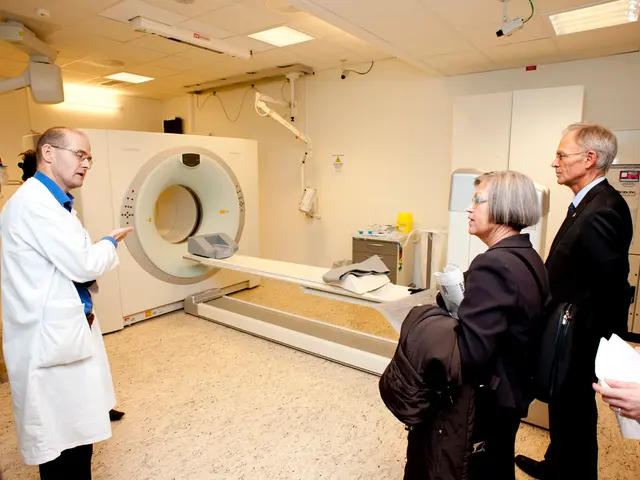Discrepancy in Mirror Neurons and Autism Spectrum Disorders
Autism and the Divergent Mirror Neuron System
An escalating body of research is delving into the relationship between Autism Spectrum Disorder (ASD) and the mirror neuron system, a neural mechanism crucial for empathy, imitation, and social learning. Using cutting-edge brain imaging techniques, researchers have identified distinct patterns in the functioning of these neurons between children with ASD and their neurotypical counterparts. These findings are reshaping our understanding of ASD, offering promising avenues for support strategies, particularly for addressing the common sensory-motor and social challenges in ASD-affected children.
Key Insights
- Neurological distinctions between the mirror neuron systems of children with ASD and neurotypical children have been observed during the observation of other people's actions.
- Advanced tools like functional magnetic resonance imaging (fMRI) and electroencephalography (EEG) have revealed variations in motor resonance and brain connectivity in ASD.
- The altered mirror neuron system may contribute to difficulties in imitation, empathy, and interpreting social cues in children with ASD.
These discoveries may provide crucial guidance for strategies that promote sensory-motor integration and social learning in ASD.
Also Read: *The Complexity of Brain Neurons as Parallel Computers*
Damage Done: A Closer Look at the Mirror Neuron System in ASD
Mirror neurons are a unique set of brain cells that activate when an individual performs an action and when they witness someone else performing the same action. These neurons are believed to play a fundamental role in learning and social interactions. In neurotypical development, the mirror neuron system enables children to comprehend others' intentions, as demonstrated when a child observes someone reaching for a cup, and their mirror neurons fire to reflect both the action and the presumed goal.
However, in ASD, this system appears to function differently, which may account for common behavioral traits such as difficulty interpreting body language, reduced spontaneous imitation, and limited responsiveness to social gestures.
Enlightening Recent Findings
Recent studies from cognitive neuroscientists at Radboud University have shed new light on the mirror neuron system in ASD. These studies involved children with ASD and neurotypical children who were made to observe videos of people performing simple actions, such as grasping objects. Using high-resolution EEG and fMRI, the researchers measured brain activity in motor-sensitive brain regions during the action observation.
Children with ASD displayed diminished activity in both the mu rhythm suppression on EEG and reduced activation in motor cortex regions during the videos. In contrast, neurotypical children demonstrated clear mirror resonance responses, indicating stronger coupling between observed motion and their own motor representations. These results underscore the hypothesis that mirror neuron system dysfunction is closely tied to the sensory-motor processing differences seen in ASD.
"This study offers some of the most compelling evidence to date that disrupted motor resonance may contribute to core social difficulties in autism," said one of the study’s senior authors, Dr. Sander Begeer.
Also Read: *Robotics: An Engineering or Computer Science Endeavor?*
An Analysis of Brain Activity: ASD versus Neurotypical Children
A comparison of neural responses during the action observation trials between both groups highlights the following key differences:
These distinctions reinforce the notion that the autistic brain processes observed movement differently, which may impact how actions are interpreted and responded to in social situations.
The Mirror Neuron Shortfall: Implications for Education and Intervention
Understanding the impact of the mirror neuron system differences on children with ASD has important implications for educational and developmental support strategies. Traditional approaches often focus on direct modeling and imitation, which may not prove effective in ASD children due to the weakness in the mirror system engagement. Interventions incorporating multi-sensory cues, movement-based teaching, or virtual environments may yield better results by creating alternative pathways for learning social skills.
For example, occupational therapy focusing on sensory integration can aid children with ASD in improving motor planning, which may indirectly support action understanding. Social skills training employing video modeling combined with interactive feedback might promote the development of alternative neural circuits to compensate for the mirror system differences.
In early education settings, tailored programs including gesture-enhanced communication, structured peer interaction, and guided motor play have shown promise. By aligning teaching strategies with the unique way autistic children process movement and intention, educators can better support the development of expressive and receptive communication skills.
Also Read: *Fleming's Left-Hand Rule in Motor and Robotics*
Unraveling the Neurological Basis of Motor Function in ASD
The link between mirror neurons and motor function in ASD extends beyond imitation alone. Some studies suggest that difficulty with fine and gross motor tasks in ASD may stem from a common root with mirror neuron dysfunction. Movement planning, prediction, and coordination often rely on motor circuits that overlap with the mirror system, suggesting a potential unified mechanism for both the physical and cognitive symptoms.
Since children with ASD frequently experience motor delays or coordination issues, developmental screenings and interventions targeting motor function should be prioritized in early diagnosis. Innovative tools like kinematic analysis, EEG movement tracking, and brain imaging can supply diagnostic benchmarks for assessing developmental risks more accurately.
Also Read: *Introduction to Machine Learning Algorithms*
Exploring the Path Ahead
Although the mirror neuron theory of autism has evolved over time, recent child-focused neural studies are leading to more comprehensive neurodevelopmental models. Future research is heading toward integrative approaches, considering how mirror system differences interact with sensory processing, executive functioning, and attention regulation.
Upcoming studies are investigating targeted stimulation or neurofeedback that might augment motor resonance in ASD. Research into the effects of social context and familiarity on mirror system responses in ASD may offer richer insights into adaptive learning frameworks.
Longitudinal imaging studies could further clarify whether mirror system functioning changes over time in ASD, offering timelines for intervention efficacy or markers of developmental progress.
FAQs: Understanding the Mirror Neuron System and Autism
What is the mirror neuron theory as it pertains to autism?
This theory posits that dysfunction in the mirror neuron system may underlie some of the social and communication difficulties associated with autism. It proposes that autistic individuals exhibit altered brain responses when observing or imitating others' actions.
How do mirror neurons differ in autistic individuals?
In neuroimaging studies involving children with autism and neurotypical children, autistic individuals often displayed reduced activation in mirror neuron-related brain regions during tasks that involved observing or replicating movement. These differences impact how they interpret other people's intentions, facial expressions, and gestures.
Can mirror neurons explain all the social deficits in autism?
While mirror neurons contribute to our understanding of some social challenges in autism, they do not constitute a complete explanation. The mirror neuron system plays only one part in the diverse neurocognitive profile seen in people with autism.
What part does the motor system play in autism?
The motor system is involved in gestures, imitation, coordination, and other foundational social behaviors. Disruptions in this system can impede both physical and communicative skills in autistic individuals, often overlapping with mirror neuron processing pathways.
References
Brynjolfsson, Erik, and Andrew McAfee. The Second Machine Age: Work, Progress, and Prosperity in a Time of Brilliant Technologies. W. W. Norton & Company, 2016.
Marcus, Gary, and Ernest Davis. Rebooting AI: Building Artificial Intelligence We Can Trust. Vintage, 2019.
Russell, Stuart. Human Compatible: Artificial Intelligence and the Problem of Control. Viking, 2019.
Webb, Amy. The Big Nine: How the Tech Titans and Their Thinking Machines Could Warp Humanity. PublicAffairs, 2019.
Crevier, Daniel. AI: The Tumultuous History of the Search for Artificial Intelligence. Basic Books, 1993.
- In studying Autism Spectrum Disorder (ASD), research reveals distinct patterns in the mirror neuron system, which play a crucial role in empathy, imitation, and social learning.
- Recent investigations using advanced tools like functional magnetic resonance imaging (fMRI) and electroencephalography (EEG) indicate variations in motor resonance and brain connectivity in ASD-affected children, which may contribute to difficulties in imitation, empathy, and interpreting social cues.
- As advances in robotics continue, there is potential for these technologies to aid in understanding neurological disorders, such as ASD, through the development of more sophisticated models of human cognition and behavior.
- Machine learning algorithms can also be applied to analyze vast amounts of data related to medical conditions, including chronic diseases and mental health issues, to predict and better understand the complex interplay between these conditions and various factors, including genetics, lifestyle, and environment.
- The integration of AI, machine learning, and robotics in healthcare can help unlock new treatments and therapies for neurological disorders like ASD, mental health conditions, and neurological disorders, ultimately improving health-and-wellness outcomes for individuals affected by these challenges.




